
Mesathalassa is one of several continents located on Galbar. Located west of the Fractal Sea, east of theMetatic Ocean and south of the Pantalei / Pictaraika, this region is typically divided into three areas, Northern, Eastern and Western, based on the pockets created by the Halagan mountains. Home to a diverse variety of Hain and Human cultures, this lush region is one of the few lacking any sort of divine empire or heroic kingdom.
There are two theories for the name of the region. One says that it is an early human translation of the Hainspeak word for Sea of Mesas, from which the first humans in the region came. The other, is that the name is based on a Dawnman term for Between Seas. The answer typically varies depending on whether the person answering has a lip or a beak.
History[]
Pre-Eusalic[]
The first boundaries of Mesathalassa are as old as godly presence on Galbar, the impact of Jvan's arrival on the planet creating the Fractal Sea and the Hagalan fault, which would later be influenced by the creation of the Darkened Spires and the Ironhearts. The creation of the Darkened Spires led to the formation of the Duskland demarking the northern boundary of the region and starting the isolation of the region.
Eusalic and Early Ikanotita[]
As usual for Galbar, Hain were the first settlers of Proto-Mesathalassa. Without a direct visit from Slough, the region's fauna was quite gentle compared to the rest of the world, only having megafauna such as giant sloths and sabertooth tigers at its worst. On the other side, the hot tropical climate of the region made it hard for Hain to fully settle it, preferring to stay on the coast (which at the time only exist in the east) or at the rivers and waterfalls of the inner jungle.
As Hain society became more complex, the very first settlements and cultures formed in the region, such as Greyview, on what is today the north end of Western Mesathalassa, and proto-Fibeslay, on the Fractal Coast. At the end of Hain Antiquity, the first mention of the Fiber Slayer legend arrived in the region (the actual event happened far from there) and led to the creation of the Fibeslay clan.
Silver Antiquity[]
Human arrival on Mesathalassa was somewhat delayed due to the condition of the region, with an ocean to the east, the dark lands to the north and a newly formed desert region (due to climate change and the rise of the Halagan Mountains) to the west, the region was somewhat isolated. Two groups would arrive eventually.
In the north, the countless tribes that dared to travel in the dark, the Duskmen, tried to move into the brighter Mesathalassan lands, but since the dark clouds made it easier for Hain to live in the borders of that land, they were successfully fought back to the grey swamps. To this day forts from that war, such as Greyview (Now called Grehvew), still dot the northern frontier, though most are derelict.
From the west, through the badlands, came the Dawnmen, a far more organized group that, unlike the Dusklanders, had its roots in a well-defined Arconian culture. Catching the western hain, who struggled with the recent increase in heat, by surprise, this human group quickly and violently spread itself through what is now Western Mesathalassa.
Dawnman would go on and form the first permanent human settlements in the region (the first camps and such are credited to the reindeer herding tribes of the deep south), mostly in the conquered West, but also, to a minor extent, in the thicker jungles of the North. They would also lay the foundations for the Halagan Shamanic Tradition, building many of the key shrine sites and megalithic monuments.
White Antiquity[]
Dawnman development came to a sudden halt due to the very thing that gives the name to this age, the White Ocean, which was created by Toun, decimating the human heartland and creating Mesathalassa proper, a land between seas. It was, however, not the sea and flood itself that brought them down.
While advanced in terms of settlement building and culture, the isolation from the human heartlands and the limited resources of Western Mesathalassa at the time stumped their population growth and military preparation. When other tribes, fleeing from the advancing sea, flooded into the region, they were quickly subjugated by these groups.
There were countless groups fleeing into the region, even if the badlands still provided a considerable barrier, but two large groups would be the key cultures to replace the Dawnman and a good many Hain.
Imgar, once a significant human kingdom in the heartland, organized a massive exodus, trying to safeguard their realm. The king died mid-journey, a great many supplies were lost, his two sons decided an exodus was a good time for a war of succession and the dream of a new Imgar kingdom was quickly lost. In spite of this, the self-declared Sunmen (who started this whole daytime ethnicity terminology) would manage to settle half of the Western Coast and all of the Western Wildland.
The other group was a loose confederation of nomad tribes and small villages, which had been on the rise, before their whole world started to sink. Unlike the Imgar migration, there was no organization, it was everyone for themselves once leadership crumbled under the weight of the diluvian exodus.
Called Evemen by the Imgar descendant tribes, this group would not only struggle for the northwestern coast from Sunmen and Dawnmen alike, but would also continue their raiding all the way to Northern Mesathalassa. The Hain and Dawnmen there had just left a long and excruciating conflict, making them easy prey and bringing an abrupt end to centuries of rivalry in the region.
Red Antiquity[]
With the diluvian chaos left behind, Mesathalassa quickly started to see the rise of settlements and organized culture again. In fact, the East Coast had not faced much trouble during this time, and many harbor-towns had developed, including the vibrant Fibeslay culture.
Equivalents in the west would appear soon after, Habour Kingdoms formed, with a system where a king owns the harbor, but the people own the boats. Some republics also appeared, including the one at Igar-Kuri (Port of the Imgar, known as Tri-Harbor in Hainspeak), after an exodus of the local nobility, who, still fighting between the two successors, would form the harbor towns of Imgar, twice, getting both cities to be nicknamed Imganana and Imganice, the suffixes meaning big and little in a fraternal context.
In the Western Wildland, the new populations quickly took to the Dawman religion, but also mixing it with new faith and culture. This formed the Halagan Shamanic Tradition, which quickly became softly organized. "Innkeeps" started to form in the wildland and became meeting points for the wandering tribes of the region, these facilities were backed by shamans, but were also semi-independent from the main order.
Mesathalassa would end up one of the many regions targeted by the Vestecian horde, though indirectly, as they traveled to fight the Pronobii. Due to this, a lot of direct combat was avoided for the region, though a few villages ended up being raided or destroyed.
The Northern Wildlands would see the rise of an organization called The Wanderers, a guild of hunters and cartographers based on the teachings of a woman from the Western Wildlands called Susa.
In the north white coast, in the valley of Cogne, the trader family Vascogne started to rise, starting to control deals from Grehvew to Lacesol during the reign of Marel Vascogne. It was them too, who discovered and spread grapes and wine, which became their main trade good in the region and beyond.
First Era After the Realta[]
With the lack of many mixed hain/human communities, half of Mesathalassa was greatly spared of the terrors that happened during the attack of the Realta. Even the Hain side, which did suffer many attacks, ended up being a secondary target to the forces that raided the Fractal Coast. The cultural impact, however, was not weaker, on the contrary, the largely unscathed governments and religious orders quickly took suspicious and retrogressive actions in face of the disaster, even in communities led by wise kings such as Fibeslay.
Agriculture started to spread not too soon after the attack, on the Hain side of the continent, the village of Tallgrass became an invisible lead of innovations, as it housed Gerrik, a disciple of the god Teknall.

Geography[]
Mesathalassa is a large region encompassing many climates. The majority of it is covered by rainforest, fed by the trapping of oceanic humidity by the Halagans and the Darkened Spires, which appears in different forms on all of the three sections of the continent.
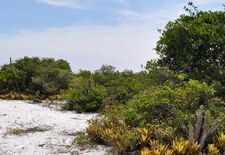
Example of Restinga
In the North, the land is far steeper due to the spires and the split of the Halagan, it is also is the region with the most rain overall, both factors combined giving the region its characteristic look of an ever humid landscape dotted by waterfalls. The region's only shore, the fractal shore, is sandy and dry, which stops the jungle, but leads to the creation of the restinga, composed of small plants and cacti.
The West has the tallest and least thick of the jungle regions, making it easy for a great many tribes to traverse the area. The west is unique in the fact that the jungle actually reaches the coast, the difference between the wildland and the urbanized area being the size and hardness of the trees. In the north, due to the surge of cold from the Darkened Spires, the jungle gives in to the Araucaria forest; the same happens in the south, creating the drier Redwood forest. Also in the south is a large swampland, the Zujau.
The East has the thickest jungle, creating a cooling effect greatly appreciated by the Hain population that lives in the wildlands. As the region becomes wider in the south, a savanna region is created between the jungle and the coastal area. The fractal coast is a lush and plain region of palm forests and lagoons.

The strange isolated forest.
In the south, there is little but a great tundra expanse. In the northern horn of the Aorta Bay in the fractal sea is a mysterious forest isolated from the continent by the jagged rocks of the spires; it is composed of great ferns and bamboo-like trees.
Flora and Fauna[]
Fauna[]
Some of the most iconic fauna of Mesathalassa are the mammalian megafauna that live in much of the western jungle and eastern open fields. Giant sloths, otters, and deer, the short-faced bears, and others are often spotted in the interior of the continent. On the coast, the animals are a bit smaller, with the exception of a few giant turtle species up in the north coast. What you will typically find there are species such as the anteater, small monkeys, violet slugs, foxes and the capybara.
Bird species in the region are less colorful than what you can find in the Deepwoods or Shalanoir, but there is still a great variety to them, with a noted presence of a variety of flightless birds such as the seriema and the kiwi, and raptors such as hawks, vultures, and owls.
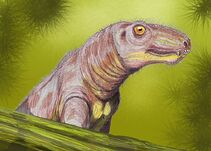
In the north, the megafauna isn't as present. In turn, there is a greater presence of feline predators such as the jaguar, a variety of Gorgonopsia, and great lizards. On the Fractal Coast, there is a pocket of Drenched Flowerbed variants, such as the Mesathalassan Frondy Walrus known for its bright black coloration.
As far as domesticated fauna goes, Mesathalassa does not have many species. The pixiehound, a glamourized canine species that is known for its small size and intelligence has made its way into the human settlements, but, like most mammals, are hated by the Hain, who much prefer birds and lizards. Violet Slugs have been tamed in Tallgrass, as well as some fowl species on both coasts. Falconry is a common practice of northern hunters.
Flora[]
Needless to say, a great variety of plants are natural to Mesathalassa's lush forests, however, a few stand out due to cultural or economic significance.
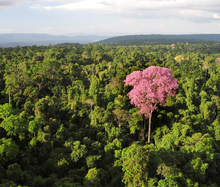
A lone Ipe
The trumpet tree, or the Ipe, is a jungle tree that is known for blooming into beautiful, colorful flowers once a year. Typically a lone tree, with the exception of the Kivicois Tall Garden region, it has been planted near human and hain settlements since antiquity. The araucaria from the borderlands with the dusklands are another iconic tree of the region, as is the redwood of the colder south. On the east coast, the mangrove trees and baobab are a common sight.
Since antiquity locals have been selecting plants they considered useful or tasty, creating a culture of orchards and plantations even before formal agriculture. Of the known domesticated plants, there are the staples Cassava in the West and Potato and Wheat in the East. Cotton is one of the main sources of fibers in the region, and there is a variety of complementary crops and fruit such as Tomatoes, Peas, Onions, Açai, Cocoa, Coconuts, Bread Fruit and Pumpkin/Squash. There is also a variety of spices that have yet to be discovered. Grapes are already planted in organized orchards on the west coast.
On the southern fractal coast, locals have domesticated an odd species of fungus, the prototaxites, which grow tall and thin. The species is used for two things: the harder one is submerged in calcium rich lime, which turns it into a hard log-like material which is used in structures; the softer one is used as a source of food.
Key Cities[]
See also: Harbor Kingdoms
There are countless village and cities within Mesathalassa, most still developing a significant sedentary population in a world where agriculture is still new. However, a few can be said to be key cities which influence their regional culture and/or hold great economical importance.
Fibeslay[]
Also known as Matafibra, Faberay, Pabelen. 10,000 pop.

A vibrant port in the Fractal coast, Fibeslay is home to the legendary Fiber Slayer clam and home to a great many legends as well as the great lighthouse, which not only is the first one built outside of Alefpria, but also the largest in Galbar.
The city is a great exporter of culture, trading pottery and clothes to other towns as a way to establish itself. It was built in the particular Hain style that avoids the use of loose fibers, with round and smooth buildings with leather roofs.
Tallgrass[]
Also known as Gramalta, Tagraz, Jerry. 300 pop.
A small village with little permanent population, yet it recently became the most well known Hain village of the inner eastern lands due to its trade. It is the home of Gerrik, who was instrumental in developing agriculture in the region and coordinating Tallgrass' trade. It's population is rapidly growing.
Susa[]
Also known as Suze, Shire. 2,000 pop.
A hunting village in the heart of Northern Mesathalassa and home to The Wanderers. A quickly developing village with a vast wealth of information first given by the legendary Susa of the Ranes herself.
Kodekzia[]

Also known as Cognalia, Kohes-Kuri. 6,000 pop.
At the mouth of the Cogne river, Kodekzia is the second largest of the Harbor Kingdoms, though its lack of sub-villages makes it be only fifth in population. This town is the birthplace of one of the two written human languages of Mesathalassa.
Igar-Kuri[]
Also known as Tri-Harbor. 23,000 pop.
The largest and most populous town in Mesathalassa, this town is better described as a huge mess that somehow works. Formed by a collection of smaller ports (smashed together in three clusters, thus why foreigners call it Tri-Habor) this town has access to a large fishing area, including a few islands that are the remains of the once sprawling desert that blocked human passage to Mesathalassa.
Grehvew[]
Also known as Greyview, Reswail, Gjerehvilli. 900 pop.
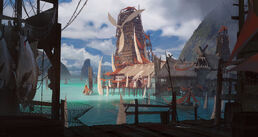
Grehvew is an old fort, first built by the Hain as Greyview to keep an eye at the Dusklands, then conquered by the Dawnmen, then the Evemen. It is a weird town with a mix of leftover architecture from all groups and a few more.
It is the oldest settlement of Mesathalassa, though it hardly has a continuous history. The small harbor, specialized in silks and goods traded by the Duskmen, is built on the side of the old fort.
Demographics[]
Human[]
Mesathalassa is home to a huge variety of human ethnicities and cultural groups, and while the boundaries are not clear cut, one can divide a good portion of the human population in three large groups by origin and linguistic root.
Dawnman[]
The original human population of Mesathalassa, they have been going through rapid decline ever since the creation of the White Sea. Only a handful of tribes and no major towns still speak their language, though much of their culture and looks lives on in many corners of Mesathalassa.
Dawnman typically have beige or olive skin, black hair and down turned eyes of blue or grey colors.

Lifprasil's general, Susa, is of Sunmen descent.
Sunman[]
The largest group from Lacesol to Krastas and through the entire western wildland, this group is typically referred as Imgar, but that would be a stretch, as nobody but a few harbour towns identifies as that or sees the old human heartland kingdom as important to them.
Sunman typically have skin of pale ochre, light brown or dark brown colors, bright purple, yellow or red eyes and very thin facial features.
Eveman[]
The largest group from Kodekzia to Grehvew and through the whole north wildlands. Nobody call themselves Eveman, not the people from the harbors, nor the wanderers of the north, who call anyone south of the Halagan "Ranes".
Eveman typically have pale beige skin, wavy light or dark brown hair, brown eyes and a round-ish facial shapes.
Duskman[]
A group that lives in the northern border and is not very significant in Mesathalassa, yet they are still part of the Imgar 'times of the day' classification. Its a wide group of people, with many origins from wave after wave of immigration and integration but a similar language root.
This group features skin ranging from very pale white to blue black, always with a hint of grey or silver. Hair in a variety of pale shades, including white and variations of grey and silver, as well as deep black.
Hain[]
The Mesathalassan Hain population is far more homogeneous than the human counterpart, as is typical of the Hain genetics. Even if isolated from the rest of the population for a long time, the local Hain are not very different from any other group, though, after such a long time, there are a few changes, such as larger beaks.
Oddly, while genetic and cultural diversity is low, the linguistic diversity is huge among the Hain. Although the Fibeslay dialect has been adopted as the lingua franca, many corners of the Eastern half of the continent have languages with entirely unique roots.

Culture[]
Government[]
There are no large formal governments in Mesathalassa, the cities and villages being either city-states or part of soft rule organizations such as The Wanderers or Innkeepers. Most people live under some form or another of despotism, although there are some city-states and villages where the ruler is elected.
Near Harbor Kingdoms, a not so clear system of vassalage exists. The system goes from the king who owns harbors, to the people who own boats, to the people who work on said boats. While the system typically only exists within the cities, as the populations increased it has started to influence nearby towns deeper inland, with kings offering to let them use their harbor or boat-owners offering work, creating some sort of hierarchy between settlements.
Religion[]
There is a great plurality to religious beliefs in Mesathalassa with many different views of the cosmos, yet, the Pantheon of Gods is quite similar from west to east. This is due to Fibeslay's art, which not only influenced the local Hain, but also greatly influenced the Human population which only had Arconian beliefs at that point.
Fibeslay's Pantheon has a few peculiarities, the main one is that no god, real or or not, is called by any translation of its proper name. Its not Jvan, it is The Crawling One. This has led to translations from one region to another, so humans will call Slough Kedyav-Mudzif or Choyatsnyopa, or sometimes both, as sometimes one translation of a god's name makes it to a region as a new god, instead of an alternate name for a god they already had. Add that to the many elementals regarded as gods and the entirely created gods, and you have a wide range of different religions even if the core pantheon is similar.
Humans brought over Elysean Cults and great many myths, which persisted due to Imgar culture, though with many alterations caused by the cut from the homeland and the mixing with the full pantheon. "The fields of lavender" is a highly romanticized Arcon, where legends say no animal was larger than a house or hideous to the eye, there was no famine and all spirits of the wind and sea were gentle.
The Halagan Shamanistic Tradition is not a religion proper, as it does not enforce what gods to believe or not, but among its many lessons, some religious traditions were spread. The most noticeable one is a division between Earthly Gods and Heavenly Gods.
Education[]
Despite being a somewhat primitive region, there is an impressive amount of educational structures in the continent that reach beyond the borders of a single village or city. The Halagan Shamanistic Tradition, for example, is a huge and complex system of teaching that discretely exchanges knowledge and people between isolated deep jungle villages. It focuses on a wide variety of topics from medicine, to wood crafting, to common tradition, and despite being divided in a variety of specialty branches named after animals, one still gets a good general knowledge by going through the shamanic ranks.
The Wanderers are a more central, less complex and more open group. Unlike the shamans of the south, studying with them is not mandatory. Their teachings are divided between lower learning and higher learning, similar to the Halagan Shamans, where the former are the basics of survival and crafting, while the latter is a more prestigious and conceptual study focusing on raising new leaders for the group.
Most major cities have some form of teaching cycle or another, though more organized cities, such as Kivico or Jan, have a more formal and effective system. Kodekzia has the only school of scribes in the region. Chippers are influential on the Fractal Coast, and Tallgrass is an emerging teaching center.
Economy[]
Most of Mesathalassa lives on subsistence and isolation, with hunter gatherer tribes and fishing villages. Some level of trade, however, exists in even the sparsely populated areas due to sculptors and traveling white giant riders. Among the larger harbor towns and some key villages the trade of obsidian is important as a way to keep a military edge.
Trade is more refined on the Metatic Coast, where trade routes for goods such as Duskland Silk from Grehvew, the copper tools of Mirny or Vascogne wine. Also important is the Salt Road, a long route that goes all the way to Citadel Dundee and traveled mostly by reindeer riding merchants.
Architecture[]
In human lands, architecture is typically defined by which migration constructed the town or village.
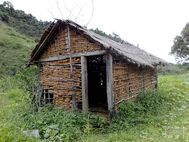
Dawnmen built mostly using stone and typically centered the village around a large and round stone building (which can be seen to this day in places like Grehvew and Tabatha). Evemen heavily use clay and prefer smoother houses, seeing wood as dangerous. Sunmen have a large tradition of building with wood and making their houses long; it is also not uncommon for them to build over flood areas or even floating boathouses. Cities typically have a mix-match of the many styles, and some even still have traces of Hain influence.
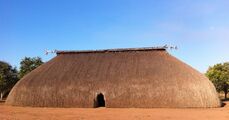
In hain lands, the style variation is more of a regional issue, having had more time to mature than the human one, with each region developing its own style. The common theme is the use of smooth surfaces, the avoidance of loose fibers and a focus on large homes without many rooms due to social and familial structure. Typically, houses are built using hides, stone, clay and wood. When there is no option but to use fibers, hain make sure that they are perfectly smooth and avoiding rougher styles.
Trivia[]
- The region's primary initial influence was South America, specially Brazil. The reasoning behind that was introducing concepts I (Capy) was familiar with but that were not common to others. However, since the beginning that was not the sole influence and it only became more of a detail as proper world-building was done.
- The first time the region was officially featured was in this post. It claims that the Fiber Slaying event took place there, but that was Capy being dumb, so the canon is that the Fiber Slayer clan either migrated to half a world away or was founded by a liar.
- The first mention of the name Mesathalassa is in First Parade 3. In First Parade 1 and 2 it is mentioned as Mesothalassa. The First Parade story seems to be the first one that tries to give the region a name.